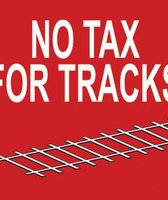Get PolitiFact in your inbox.
Greenlight Pinellas opponent says 'light rail does not reduce congestion'
Critics of the Greenlight Pinellas mass transit initiative are attacking the plan at full speed by questioning the effectiveness of the proposal’s light rail line.
The group’s home page, RailTaxFacts.com, features a commercial arguing against pro-transit talking points, such as light rail creating long-term economic growth and reducing traffic congestion. The video shows a "Truth Meter" (not to be confused with PolitiFact Florida’s Truth-O-Meter) rating the statements false.
"Light rail does not reduce congestion," the website says under the video.
Greenlight Pinellas plans a 24-mile light rail route from St. Petersburg to Clearwater projected to cost $2 billion over a decade. We wondered if the idea of reduced congestion was a dependable guidepost, or if we’re all being taken for a ride.
Railing against rail
Light rail is generally considered to be a rail line that either shares space with roads or is a separate, above-ground commuter line, as opposed to a subway or elevated train. The Greenlight Pinellas plan calls for a proposed line with 16 stations to provide a 57-minute total trip time between St. Pete and Clearwater. It’s slated to be installed and operational within 10 years and serve as an anchor for future transit additions.
Greenlight also has plans for bus rapid transit and expanded service, which we’ve addressed before, but in this case, No Tax For Tracks says a common talking point by light rail advocates is that a rail system will decrease congestion.
One of the group’s supporting links is a Washington Post Wonkblog post linking to another post from The Atlantic suggesting light rail’s effects on congestion are debatable. The other piece of evidence is an April 2014 analysis by David McKalip, a St. Petersburg neurosurgeon and No Tax For Tracks supporter, concluding light rail actually increases congestion.
McKalip writes about how despite extensive rail investment in Portland, Ore., the city saw more people in cars and higher traffic volumes in the subsequent years. He also cites another Atlantic post discussing a study of four British cities that showed light rail didn’t get people out of their cars, but did take them off buses.
"I have yet to find any science ever that says congestion goes down," McKalip told PolitiFact Florida. "Experts say, ‘do not make that assertion.’ "
McKalip followed up his post with another on July 1 saying car travel times in the Tampa Bay area are routinely faster than in other cities with rail and there is no concrete evidence of a relationship between congestion reduction and light rail.
Featured Fact-check
An essay by public transit planning consultant and author Jarrett Walker says that while transit has several benefits that make cities more sustainable and improves quality of life, a definite correlation between service and fewer cars isn’t apparent.
Thinking ahead
Many transit experts don’t agree with that conclusion.
Todd Litman, founder and executive director of the Victoria Transport Policy Institute in Canada, said "traffic congestion and economic impacts vary considerably depending on specific circumstances and how the impacts are measured."
He said that a transit system with sufficient demand and adequate supporting policies can indeed reduce congestion. He cited several studies that showed congestion increased at a higher rate in areas without light rail.
One showed that in Denver, there was a 31 percent increase in vehicle traffic in light rail corridors, as opposed to 41 percent elsewhere. Another said Baltimore’s congestion increase dropped from 2.8 percent to 1.5 percent annually after building light rail. One Los Angeles study said people who lived within a half-mile of one light rail line in the city traveled an average of 10 to 12 miles less by car per day. Another said that Utah’s TRAX system dropped the estimated number of vehicles on the studied corridor from 44,000 to 22,300 per day.
PSTA told PolitiFact Florida that reducing future congestion is the guideline Greenlight Pinellas is addressing, offering Pinellas County residents a transportation option in the face of projected population growth across the region.
Vukan Vuchic, transportation engineering professor at the University of Pennsylvania, said that’s a sufficient way to measure a reduction in congestion. Cities inevitably will keep growing, and thanks to an ingrained car culture, the only way to ensure a net loss of vehicles is to completely reorganize entire cities with pedestrian zones and policies that make car ownership prohibitive.
"Yes, we see people are buying more cars and driving more miles, but we didn’t give people a choice," he said, adding that communities must make a conscious choice to enact many policies aimed at reducing congestion. "It’s not automatic. It’s not like you put in a rail line and it’s automatically beautiful."
Our ruling
No Tax For Tracks said "light rail does not reduce congestion."
The studies we looked at didn’t show a strict reduction in congestion. However, there are studies that show congestion grows more slowly in communities that have implemented light rail, especially if they do so in conjunction with other policies that give people an option not to drive.
We rate the statement Half True.
Our Sources
RailTaxFacts.com, April 2014
HumanTransit.org, "What does transit do about traffic congestion? (updated)," July 29, 2010
MetroTransit, "Before & After Study: Hiawatha Light Rail Transit Line, August 2010
American Economic Review, "The Fundamental Law of Road Congestion: Evidence from US Cities," 2011
Victoria Transport Policy Institute, "Rail Transit in America," January 2012
Citylab.com, "Does Light Rail Really Alleviate Highway Congestion?," Feb, 29, 2012
Journal of Transport Geography, "Impact of light rail on traffic congestion in Denver," May 2012
Texas A&M Transportation Institute, "Urban Mobility Report," December 2012
Citylab.com, "Does Light Rail Really Encourage People to Stop Driving?," Feb. 26, 2013
Washington Post Wonkblog, "Do light-rail systems help cut down on traffic? Perhaps not.," Feb. 27, 2013
Journal of Transport Geography, "Do light rail services discourage car ownership and use? Evidence from Census data for four English cities," May 2013
SunbeamTimes.com, "Car Congestion Increases With Light Rail," April 9, 2014
Victoria Transport Policy Institute, "Smart Congestion Relief," June 2014
Victoria Transport Policy Institute, "Congestion Costing Critique," June 2014
National Institute for Transportation and Communities, "Effect of Light-Rail Transit on Traffic in a Travel Corridor," June 2014
Greenlight Pinellas, "Future passenger rail," accessed June 25, 2014
University of Southern California, "The Exposition Light Rail Line Study A Before-and-After Study of the Impact of New Light Rail Transit Service," accessed June 30, 2014
SunbeamTimes.com, "Rail Does Not Decrease Car Congestion; Greenlight’s Claims are False.," July 1, 2014
Interview with Allen Biehler, Carnegie Mellon University transportation systems and policy professor, June 25, 2014
Interview with Vukan Vuchic, University of Pennsylvania transportation engineering professor, June 30, 2014
Interview with Todd Litman, Victoria Transport Policy Institute executive director, June 30, 2014
Interview with David McKalip, No Tax For Tracks supporter, July 2, 2014
Interview with Cassandra Borchers, PSTA chief development officer, July 2, 2014
Browse the Truth-O-Meter
More by Joshua Gillin
Greenlight Pinellas opponent says 'light rail does not reduce congestion'
Support independent fact-checking.
Become a member!
In a world of wild talk and fake news, help us stand up for the facts.




































